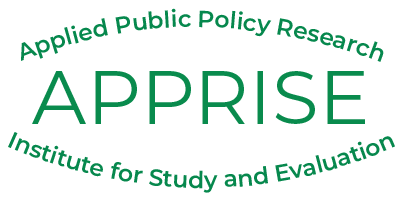RESOURCE LIBRARY
APPRISE Selected Reports
Residential Market Transformation Research and Evaluation
The Illinois Power Agency (IPA) contracted with APPRISE to conduct an evaluation of the Illinois Solar for All (ILSFA) Program. The ILSFA Program aims to bring photovoltaics to low-income communities in Illinois. The objectives of the program are to maximize the development of new photovoltaic generating facilities, create a long-term, low-income solar marketplace throughout the State, integrate with existing energy efficiency initiatives, and minimize administrative costs.
The Phase I Evaluation report presents results from the first phase of the evaluation, which was conducted from August through September 2019. Future evaluation research will include more detailed review of program implementation, barriers, accomplishments, and results as the program implementation progresses. Download Here.
The Illinois Power Agency (IPA) contracted with APPRISE to conduct an evaluation of the Illinois Solar for All (ILSFA) Program. The ILSFA Program aims to bring photovoltaics to low-income communities in Illinois. The objectives of the program are to maximize the development of new photovoltaic generating facilities, create a long-term, low-income solar marketplace throughout the State, integrate with existing energy efficiency initiatives, and minimize administrative costs.
The First Interim Report presents the findings from the first portion of the Phase II Evaluation, which was conducted from October 2019 through January 2020 and included a review of program implementation, barriers, accomplishments, and results. Download Here.
The Illinois Power Agency (IPA) contracted with APPRISE to conduct an evaluation of the Illinois Solar for All (ILSFA) Program. The ILSFA Program aims to bring photovoltaics to low-income communities in Illinois. The objectives of the program are to maximize the development of new photovoltaic generating facilities, create a long-term, low-income solar marketplace throughout the State, integrate with existing energy efficiency initiatives, and minimize administrative costs.
The Second Interim Report presents the findings from the second portion of the Phase II Evaluation, which was conducted from January 2020 through May 2020 and included a review of program implementation, barriers, accomplishments, and results. Download Here.
The Illinois Power Agency (IPA) contracted with APPRISE to conduct an evaluation of the Illinois Solar for All (ILSFA) Program. The ILSFA Program aims to bring photovoltaics to low-income communities in Illinois. The objectives of the program are to maximize the development of new photovoltaic generating facilities, create a long-term, low-income solar marketplace throughout the State, integrate with existing energy efficiency initiatives, and minimize administrative costs.
The Third Interim Report presents the findings from the third portion of the Phase II Evaluation, which was conducted from June 2020 through December 2020 and included a review of program implementation, barriers, accomplishments, and results. Download Here.
The Illinois Power Agency (IPA) contracted with APPRISE to conduct an evaluation of the Illinois Solar for All (ILSFA) Program. The ILSFA Program aims to bring photovoltaics to low-income communities in Illinois. The objectives of the program are to maximize the development of new photovoltaic generating facilities, create a long-term, low-income solar marketplace throughout the State, integrate with existing energy efficiency initiatives, and minimize administrative costs.
The Phase II Final Evaluation Report is the fifth and final report from the first Illinois Solar for All Program evaluation. The research conducted from August 2019 through June 2021 provided a comprehensive assessment of the program design, implementation, and impacts by interviewing IPA, Elevate, Approved Vendors, utilities, stakeholders, Grassroots Educators, Grassroots Education participants, job trainees, other state solar program managers, and green bank representatives; and by analyzing program data and other available data. The research found that the program has successfully approved numerous solar vendors, constructed solar projects, employed job trainees, and will provide benefits to low-income households and organizations in Environmental Justice and low-income communities around the state. Download Here.
The Illinois Power Agency (IPA) contracted with APPRISE to conduct an evaluation of the Illinois Solar for All (ILSFA) Program. The ILSFA Program aims to bring photovoltaics to low-income communities in Illinois. The objectives of the program are to maximize the development of new photovoltaic generating facilities, create a long-term, low-income solar marketplace throughout the State, integrate with existing energy efficiency initiatives, and minimize administrative costs.
This Summary Report provides the following information.
- ILSFA Program: This report presents an overview of the key components of ILSFA. While the ILSFA Program has evolved during the first two years of implementation, the key design characteristics of the program remain the same as in the original conception of the program.
- Evaluation: Five lengthy evaluation reports have been published. These reports provide detailed information on the program design and implementation, participating vendors, project submissions and approvals, feedback from many program actors, program impacts, assessments of the program administrator, and recommendations for program refinement. This Summary Report provides a brief description of the evaluation activities that were undertaken during the evaluation period.
- Metrics: Key metrics required by FEJA and additional metrics developed with stakeholder input are provided in this report.
- Recommendations: The recommendations developed through the research that are still applicable at the current time are summarized in this report. Additional justification for these recommendations is provided in the previous detailed evaluation reports.
However, the net program impacts for the 2005 and 2006 ENERGY STAR Homes were considerably smaller than the gross program impacts. While ENERGY STAR Homes used considerably less gas and electricity than the REM/RateTM Reference Homes, the differences between ENERGY STAR Homes and Comparison Homes that are built without ENERGY STAR incentives were considerably smaller than the differences projected by the REM/RateTM model. Download Here.
